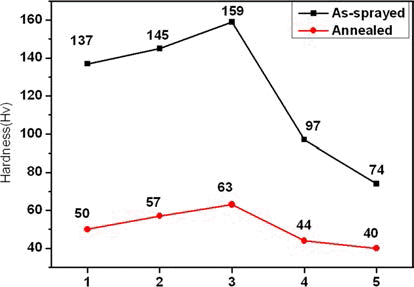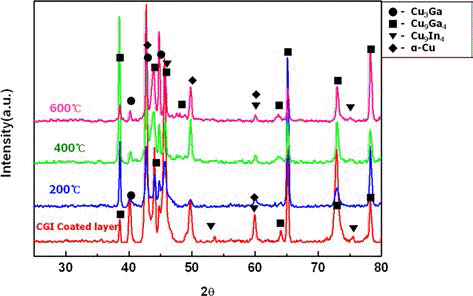Search
- Page Path
- HOME > Search
- [Korean]
- Manufacturing of Cu Repair Coating Material Using the Kinetic Spray Process and Changes in the Microstructures and Properties by Heat Treatment
- Min-Gwang Jeon, Hyung-Jun Kim, Kee-Ahn Lee
- J Korean Powder Metall Inst. 2014;21(5):349-354. Published online October 1, 2014
- DOI: https://doi.org/10.4150/KPMI.2014.21.5.349

- 682 View
- 1 Download
- 4 Citations
-
 Abstract
Abstract
 PDF
PDF This study is a basic research for repair material production which manufactured a Cu repair coating layer on the base material of a Cu plate using kinetic spray process. Furthermore, the manufactured material underwent an annealing heat treatment, and the changes of microstructure and macroscopic properties in the Cu repair coating layer and base material were examined. The powder feedstocks were sphere-shaped pure Cu powders with an average size of 27.7 μm. The produced repair coating material featured 600 μm thickness and 0.8% porosity, and it had an identical α-Cu single phase as the early powder. The produced Cu repair coating material and base material displayed extremely high adhesion characteristics that produced a boundary difficult to identify. Composition analysis confirmed that the impurities in the base material and repair coating material had no significant differences. Microstructure observation after a 500°C/1hr. heat treatment (vacuum condition) identified recovery, recrystallization and grain growth in the repair coating material and featured a more homogeneous microstructure. The hardness difference (ΔHv) between the repair coating material and base material significantly reduced from 87 to 34 after undergoing heat treatment.
-
Citations
Citations to this article as recorded by- Manufacturing of Large-Scale Cold-Sprayed Ta Target Material and Its Sputtering Property
Gi-Su Ham, Dong-Yeol Wi, Jun-Mo Yang, Kee-Ahn Lee
Journal of Thermal Spray Technology.2019; 28(8): 1974. CrossRef - High-temperature thermo-mechanical behavior of functionally graded materials produced by plasma sprayed coating: Experimental and modeling results
Kang Hyun Choi, Hyun-Su Kim, Chang Hyun Park, Gon-Ho Kim, Kyoung Ho Baik, Sung Ho Lee, Taehyung Kim, Hyoung Seop Kim
Metals and Materials International.2016; 22(5): 817. CrossRef - Fabrication and Microstructure/Properties of Bulk-typeTantalum Material by a Kinetic Spray Process
Ji-Hye Lee, Ji-Won Kim, Kee-Ahn Lee
Journal of Korean Powder Metallurgy Institute.2016; 23(1): 8. CrossRef - Effect of Heat Treatment Environment on the Microstructure and Properties of Kinetic Sprayed Tantalum Coating Layer
Ji-Hye Lee, Hyung-Jun Kim, Kee-Ahn Lee
Journal of Korean Powder Metallurgy Institute.2015; 22(1): 32. CrossRef
- Manufacturing of Large-Scale Cold-Sprayed Ta Target Material and Its Sputtering Property
- [Korean]
- Manufacturing and Properties of CGI-based Composite Coating Layer Utilizing a Warm Spray Process and Cu-Ga and Cu-In Mixed Powders
- Min-Gwang Jeon, Myeong-Ju Lee, Hyeong-Jun Kim, Kee-Ahn Lee
- J Korean Powder Metall Inst. 2014;21(3):229-234. Published online June 1, 2014
- DOI: https://doi.org/10.4150/KPMI.2014.21.3.229

- 620 View
- 0 Download
- 2 Citations
-
 Abstract
Abstract
 PDF
PDF This study manufactured a CIG-based composite coating layer utilizing a new warm spray process, and a mixed powder of Cu-20at.%Ga and Cu-20at.%In. In order to obtain the mixed powder with desired composition, the Cu-20at.%Ga and Cu-20at.%In powders were mixed with a 7:1 ratio. The mixed powder had an average particle size of 35.4 μm. Through the utilization of a warm spray process, a CIG-based composite coating layer of 180 μm thickness could be manufactured on a pure Al matrix. To analyze the microstructure and phase, the warm sprayed coating layer underwent XRD, SEM/EDS and EMPA analyses. In addition, to improve the physical properties of the coating layer, an annealing heat treatment was conducted at temperatures of 200°C, 400°C and 600°C for 1 hour each. The microstructure analysis identified α-Cu, Cu4In and Cu3Ga phases in the early mixed powder, while Cu4In disappeared, and additional Cu9In4 and Cu9Ga4 phases were identified in the warm sprayed coating layer. Porosity after annealing heat treatment reduced from 0.75% (warm sprayed coating layer) to 0.6% (after 600°C/1 hr. heat treatment), and hardness reduced from 288 Hv to 190 Hv. No significant phase changes were found after annealing heat treatment.
-
Citations
Citations to this article as recorded by- Fabrication and Microstructure/Properties of Bulk-typeTantalum Material by a Kinetic Spray Process
Ji-Hye Lee, Ji-Won Kim, Kee-Ahn Lee
Journal of Korean Powder Metallurgy Institute.2016; 23(1): 8. CrossRef - Effect of Heat Treatment Environment on the Microstructure and Properties of Kinetic Sprayed Tantalum Coating Layer
Ji-Hye Lee, Hyung-Jun Kim, Kee-Ahn Lee
Journal of Korean Powder Metallurgy Institute.2015; 22(1): 32. CrossRef
- Fabrication and Microstructure/Properties of Bulk-typeTantalum Material by a Kinetic Spray Process
- [English]
- Manufacturing and Macroscopic Properties of Cold Sprayed Cu-Ga Coating Material for Sputtering Target
- Young-Min Jin, Min-Gwang Jeon, Dong-Yong Park, Hyung-Jun Kim, Ik-Hyun Oh, Kee-Ahn Lee
- J Korean Powder Metall Inst. 2013;20(4):245-252.
- DOI: https://doi.org/10.4150/KPMI.2013.20.4.245

- 609 View
- 1 Download
- 4 Citations
-
 Abstract
Abstract
 PDF
PDF - This study attempted to manufacture a Cu-Ga coating layer via the cold spray process and to investigate the applicability of the layer as a sputtering target material. In addition, changes made to the microstructure and properties of the layer due to annealing heat treatment were evaluated, compared, and analyzed. The results showed that coating layers with a thickness of 520 mm could be manufactured via the cold spray process under optimal conditions. With the Cu-Ga coating layer, the alpha-Cu and Cu_3Ga were found to exist inside the layer regardless of annealing heat treatment. The microstructure that was minute and inhomogeneous prior to thermal treatment changed to homogeneous and dense with a more clear division of phases. A sputtering test was actually conducted using the sputtering target Cu-Ga coating layer (~2 mm thickness) that was additionally manufactured via the cold-spray coating process. Consequently, this test result confirmed that the cold sprayed Cu-Ga coating layer may be applied as a sputtering target material.
-
Citations
Citations to this article as recorded by- Microscopic Examination of Cold Spray Cermet Sn+In2O3Coatings for Sputtering Target Materials
M. Winnicki, A. Baszczuk, M. Rutkowska-Gorczyca, M. Jasiorski, A. Małachowska, W. Posadowski, Z. Znamirowski, A. Ambroziak
Scanning.2017; 2017: 1. CrossRef - Effect of powder alloy composition on the microstructure and properties of kinetic sprayed Cu-Ga based coating materials
Byung-Chul Choi, Dong-Yong Park, Kee-Ahn Lee
Metals and Materials International.2016; 22(4): 649. CrossRef - Manufacturing and Properties of CGI-based Composite Coating Layer Utilizing a Warm Spray Process and Cu-Ga and Cu-In Mixed Powders
Min-Gwang Jeon, Myeong-Ju Lee, Hyeong-Jun Kim, Kee-Ahn Lee
Journal of Korean Powder Metallurgy Institute.2014; 21(3): 229. CrossRef - Manufacturing of Cu Repair Coating Material Using the Kinetic Spray Process and Changes in the Microstructures and Properties by Heat Treatment
Min-Gwang Jeon, Hyung-Jun Kim, Kee-Ahn Lee
Journal of Korean Powder Metallurgy Institute.2014; 21(5): 349. CrossRef
- Microscopic Examination of Cold Spray Cermet Sn+In2O3Coatings for Sputtering Target Materials
TOP
 KPMI
KPMI


 First
First Prev
Prev


